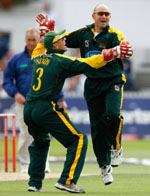Cricket fitness for older players: Eating well
This is part 2 of the "Cricket Fitness for Older Players" series. To go to part 1 click here.
It's no revelation to say that the older you get the more weight you put on. When international sports performers hit 26 or so fitness coaches start to build in weight control strategies.
Yes, 26.
While you don't need to be in the same peak condition as elite players, giving in to love handles isn't good for your cricket or your health so what you eat becomes more important as you get older.
Cricket fitness for older players
Cricket is a great game because you can continue to play it long after you have had to give up other sports. International players can go on well into their 30s (or 40s) and many club players are still turning out in their 60s.
The older you get the harder it can be to maintain your own high standards and the more you need strategies and tips to keep playing at your best.
The 7 immutable laws of cricket practice
While there's as many ways to approach training as there are cricketers, some things never change when it comes to improving your game. Here are the 7 elements that you might keep in mind when planning your practice:
Weekly Links 17th February 2007
- I have long thought the USA takes sport training and skills far more seriously than the UK. It seems I am far from alone. James Hamilton views it from a football angle.
- The medicine ball is one of the best tools for developing upper body power. Here is a great medicine ball workout.
- The 5 rules of great goal setting. A vital skill for all cricketers wanting to improve.
Club Twenty20 will save English cricket
Twenty over cricket has taken the English professional game by storm, yet it's never been touted as the answer to England's Test problems.
That is until now.
Clothing manufacturers North Gear have got hold of the idea and are running a brand new national amateur league based on the popular format.
Are you a Boycott or a Botham?
Is it true that cricketers are either a Boycott or a Botham?
It's often said to be the case that you are either cautious in nature and play safe (Boycott) or flamboyant and risky (Botham).
In fact, I have found that good players can operate using both philosophies depending on the game situation. Even Boycott could attack when he felt it needed (which wasn't very often).
Psychology is just good cricket thinking
There is no one in the UK cricket scene who knows more about sport psychology than Jeremy Snape.
He rightly points out that if 80% of cricket is in the head, why do we only spend 5% of the time working on our mental game?
 But the England international, Master in Sports Psychology, and captain of Leicestershire CCC isn't into airy-fairy discussions about your relationship with your mother. Running his own company, Sporting Edge Solutions, he leaves the word 'psychology' with all it's negative connotations at the door and trains top class players in the practical application of performance thinking.
But the England international, Master in Sports Psychology, and captain of Leicestershire CCC isn't into airy-fairy discussions about your relationship with your mother. Running his own company, Sporting Edge Solutions, he leaves the word 'psychology' with all it's negative connotations at the door and trains top class players in the practical application of performance thinking.
Ignore context to reduce pressure
If anyone knew about pressure in sport it was 5 times Olympic Gold medalist Steve Redgrave.
His method for dealing with the massive pressures of his sport work just as effectively for cricketers too.
He knew it's the context that is the problem, not the task.
The example Steve often cites is walking across a plank of wood. If the plank were a foot off the ground, most people would dash across it no problem.
How muscular can cricketers be?
Players often tell me that they don't want to 'bulk up' or become so muscular they can no longer bat or bowl efficiently.
Frankly, I think that's a bit of an excuse not to train. At the very least it's a fear you can put aside.
It's widely recognised that bowlers have to be strong and powerful to prevent injury and improve their performance. Top players train regularly in the gym to develop this.

